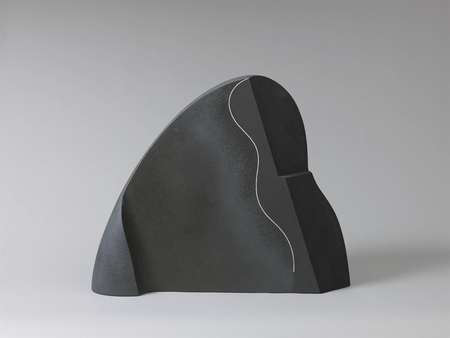Product Description
7752 Yasuo Hayashi (b. 1928)
A black ceramic sculpture of abstract form
Dated ’85 and signed Yasuo
Japan, 20th century, 1985
Dimensions: H. 59cm x W. 73cm x D. 23cm (23¼” x 29″ x 9¼”)
Tomobako (original box):
Lid: titled Hakei no gotoku (Like a wave), signed Hayashi Yasuo and sealed Yasuo
Yasuo Hayashi was born in Kyoto the son of a potter. In his early life he was interested in painting more than pottery and studied Japanese painting at Kyoto Municipal Art School together with Hisao Domoto (1928-2013) and Matazo Kayama (1927-2004), both of whom went on to become renowned painters. As Japan entered World War II, he joined the Imperial Japanese Navy Air Service and eventually applied for Tokkotai, a special unit for suicide strikes. In 1945 whilst awaiting orders for his suicidal mission in Oita, the war ended and he returned to Kyoto to resume his painting studies.
However, his pilot training during the war and the experience of spatial disorientation whilst flying in vast open spaces made it hard for Hayashi to return to two-dimensional painting and he returned home to study pottery at the family kiln. His father encouraged him to innovate and not to imitate traditional wares produced by the family, giving Hayashi the freedom to produce whatever he felt.
This freedom led Hayashi to found a study group of avant-garde ceramicists in 1947 known as Shikokai with Sango Uno (1902-1988), Yasunori Suzuki (dates unknown), and Uichi Shimizu (1926-2004). Here along with other young potters he pursued new, sculptural ceramic making rather than conventional pottery vessels.
From 1962 to 1977 Hayashi joined Sodeisha (Crawling Through Mud Association), an influential avant-garde ceramic art group founded by Kazuo Yagi (1918-1979), Osamu Suzuki (1926-2001) and Hikaru Yamada (1923-2001) amongst others, and he continued producing and exhibiting unique works created with his fine technique and well-honed senses. From 1972 to 1998 he taught ceramic making at the Osaka University of Arts and was designated as a professor emeritus for his great contribution.
Works by the artist can be found in the collections of:
The National Museum of Modern Art, Tokyo; The National Museum of Art, Osaka; Hiroshima Prefectural Museum of Art; Hokkaido Museum of Modern Art, Sapporo; The Japan Foundation, Tokyo; Kyoto Municipal Museum of Art; Kyoto Prefectural Library and Archives; Museum of Contemporary Ceramic Art, Shigaraki; The Museum of Modern Art, Wakayama; Osaka University of Arts; Takamatsu City Museum of Art; Victoria & Albert Museum, London; Wales University, Aberystwyth, UK; Museo Internazionale delle Ceramiche, Faenza, Italy; Kecskemét International Ceramic Museum, Hungary; Musée Ariana, Geneva, Switzerland; Musée Municipal de Céramique et d’Art Moderne, Vallauris, France; Musée National de Céramique, Sèvres, France; Museu de Óbidos, Portugal; Museum of Decorative Arts, Prague, Czech Republic; Museum of Arts and Design, New York; Contemporary Crafts Gallery, Portland, USA; Everson Museum of Art, Syracuse, USA; Canadian Clay & Glass Gallery, Canada; Museo de Arte Moderno, Buenos Aires, Argentina; Australia Art Gallery of Western Australia, Perth; Australian National University, Canberra; National Museum of History, Taipei, Taiwan; Seoul Metropolitan Museum, South Korea; Icheon World Ceramic Center, South Korea; Total Museum of Contemporary Art, Seoul, South Korea
Selected group exhibitions:
Modern Japanese Ceramic Exhibition, Musée Cernuschi, Paris, France, 1950
30th Faenza International Ceramic Exhibition, Italy (Grand Prix), 1972
Calgary International Ceramic Exhibition, Canada (Grand Prix), 1973
4th Vallauris International Ceramic Exhibition, France (Grand Prix, d’honneur prize), 1974
1st Obidos Beinnale, Portugal (Grand Prix), 1987
Japanese culture: the fifty post-war years, Meguro Museum of Art, Tokyo, and touring, 1995;
Viewpoint from the two, Hankyu, Umeda, 1995, and every year since;
Japanese studio craft: tradition and the avant-garde, Victoria & Albert Museum, London, UK, 1995;
Wind from Faenza, Ceratopia Toki, Gifu, 1995;
Guests from Japan, Museum für Kunst und Gewerbe, Hamburg, and Galerie für angewandte Kunst, Munich, Germany, 1995;
Tsutaka Waichi and the Genbi, Hyoto Prefectural Museum of Modern Art, Kobe, 1995;
Artists around Tsutaka Waichi and Izumi Shigeru, Keihan Gallery of Arts and Science, Moriguchi, 1996;
The world of contemporary ceramic art, IAC-KCC Special Exhibition, Total Open-air Museum, Korea, 1996;
IAC exhibition in Japan ’96, Saga Prefectural Art Museum, Saga, 1996;
Sohgen Eguchi: a movement of Japanese calligraphy after 1945, The Niigata Prefectural Museum of Modern Art, Nagaoka, 1996;
Seoul Ceramic Art Biennale 1997, Seoul Metropolitan Museum, South Korea, 1997;
New wind from Hira, Hira Museum, Shiga, 1998;
Pioneers of avant-garde ceramics after WWII: Sodeisha, Hiroshima Prefectural Museum of Art, Hiroshima, 1998;
Mathematics & ceramics, Berlin, Ofen and Keramik Museum, Velten, 1998;
Kyoto avant-garde 1933–1972, Kyoto Municipal Museum, 1998;
Post-war art in Kansai 1950s–1990s, Wakayama Prefectural Museum of Modern Art, 1999;
Kansai art exhibition, Osaka Municipal Museum, 1999;
Crafts & materials, Kyoto Municipal Museum, 1999;
Transformations: The Language of Craft, National Gallery of Australia, Canberra, 2005-2006
Selected solo exhibitions:
Sato Gallery, Tokyo, 1958;
Hankyu, Osaka, 1959;
Yoseido Gallery, Tokyo, 1959, 1960;
Galerie 16, Kyoto, 1964, 1965;
Gallery Beni, Kyoto, 1966, 1984, 1988, 1991, 1996;
Akao Gallery, Osaka, 1967;
Gallery Imai, Osaka, 1972;
Seibu, Ikebukuro, Tokyo, 1976, 1977, 1979;
Daimaru, Kobe, 1978;
Asahi Gallery, Kyoto, 1978;
Hagitei, Osaka, 1978;
Gallery Tosenbo, Kyoto, 1980;
Osaka Contemporary Art Centre, 1981;
Gallery Chaymachi, Osaka, 1982, 1983, 1992;
Gallery Nippon, Tokyo, 1982;
Daiken Gallery, Osaka, 1985;
Gallery Sanjo, Kyoto, 1985, 2000, 2002;
Gallery Haku, Osaka, 1985;
Akasaka Green Gallery, Tokyo, 1986, 1988, 1990, 1992, 1994, 1996, 1997, 2000, 2002;
Institut Franco-Japonais du Kansai, Kyoto, 1989;
Photospace Gallery, Canberra School of Art, Canberra, ACT, Australia, 1990;
Hirakata Kintetsu Art Gallery, Osaka, 1992;
Gallery Tenjiku, Tokyo, 1993;
Contemporary Crafts Gallery, Portland, OR, USA, 1993;
Galerie L, Hamburg, Germany, 1995;
Dai Ichi Arts, New York, NY, USA, 2005;
Osaka Prefectural Contemporary Art Centre, Osaka, 1998;
Aoyama Green Gallery, Tokyo, 2003;
Gion Konishi Gallery, Kyoto, 2005







